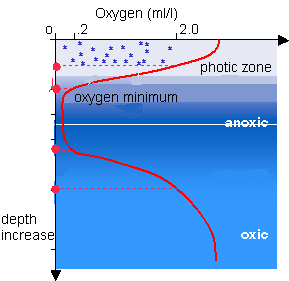"Fossil evidence suggests that animals probably evolved sometime around 600 million years ago, and large animals appear around 575 million years ago. Animals have an absolute requirement for oxygen for their respiration, so it has often been speculated that large macroscopic animals (those with the largest oxygen requirement) evolved when oxygen rose to permissible levels, which would be about 10% of those levels we have today. Our study supports this scenario by showing that the first occurrence of large respiring organisms, some of which are likely stem-group animals, emerged on the Avalon Peninsula in Newfoundland in concordance with oxygenation of this local environment."
 On Friday Don will be talking about Oxygen Minimum Zones. The Oxygen minimum zone (OMZ), is the zone in which oxygen saturation in seawater in the ocean is at its lowest. This zone occurs at depths of about 200 to 1,000 metres, depending on location. Surface ocean waters generally have O2 concentrations in equilibrium with the atmosphere. Colder waters can hold more oxygen than warmer waters. As this water sinks from the surface into deeper waters it is exposed to a rain of organic matter from above. As aerobic bacteria feed on this organic matter they use oxygen as part of the bacterial metabolic process lowering its concentration within the surrounding water. Therefore, the concentration of oxygen in deep water is dependent on the amount of oxygen it had when it was at the surface minus depletion by the degradation of organic matter. The OMZ relates to new ways scientists are looking at the 'Great Oxygenation Event'.
On Friday Don will be talking about Oxygen Minimum Zones. The Oxygen minimum zone (OMZ), is the zone in which oxygen saturation in seawater in the ocean is at its lowest. This zone occurs at depths of about 200 to 1,000 metres, depending on location. Surface ocean waters generally have O2 concentrations in equilibrium with the atmosphere. Colder waters can hold more oxygen than warmer waters. As this water sinks from the surface into deeper waters it is exposed to a rain of organic matter from above. As aerobic bacteria feed on this organic matter they use oxygen as part of the bacterial metabolic process lowering its concentration within the surrounding water. Therefore, the concentration of oxygen in deep water is dependent on the amount of oxygen it had when it was at the surface minus depletion by the degradation of organic matter. The OMZ relates to new ways scientists are looking at the 'Great Oxygenation Event'.The reading this week is another scientific paper which puts forward the idea the delivery of nutrients to the ocean following the last of the Snowball Earth Ice Ages (the Gaskiers glaciation) feed an algal (cyanobacterial) bloom that provided enough oxygen to fuel multicellular life - in other words animals. Don and his co-authors come up with this idea because the geochemistry of sediments before the Gaskiers glaciation is different from the geochemistry of the sediments afterwards.
Video primer about oxygen and photosynthesis

 The Permian extinction caused the most fundamental reorganization of ecosystems and animal diversity in the past 500 million years. The marine communities of today are largely a result of the recovery following this extinction. In addition, dinosaurs and mammals arose in the aftermath of the extinction.
The Permian extinction caused the most fundamental reorganization of ecosystems and animal diversity in the past 500 million years. The marine communities of today are largely a result of the recovery following this extinction. In addition, dinosaurs and mammals arose in the aftermath of the extinction.



